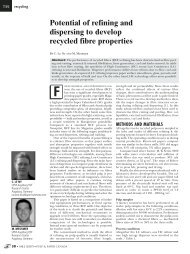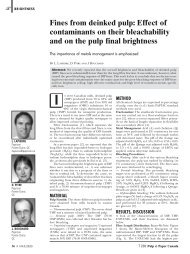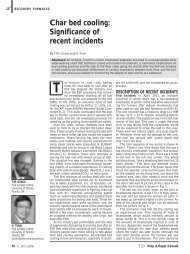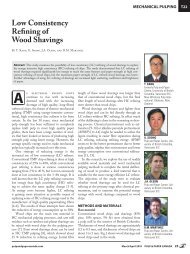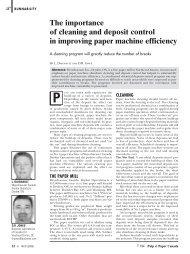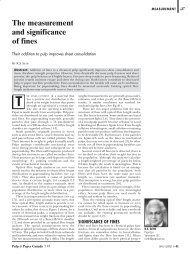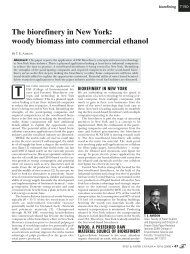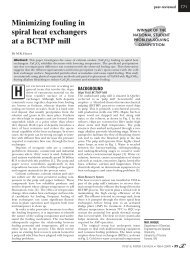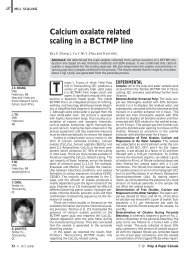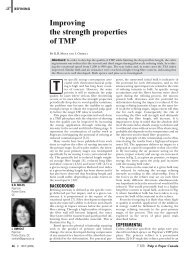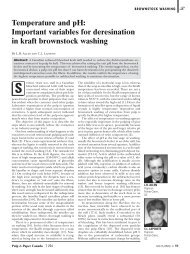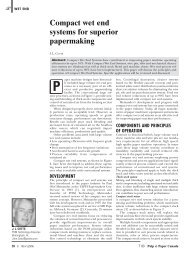Final Pulp Bleaching by Ozonation: Chemical Justification and ...
Final Pulp Bleaching by Ozonation: Chemical Justification and ...
Final Pulp Bleaching by Ozonation: Chemical Justification and ...
Create successful ePaper yourself
Turn your PDF publications into a flip-book with our unique Google optimized e-Paper software.
peer reviewedT50Ozone treatment as final bleachingThe use of ozone in pulp bleaching has been implemented inmore than 30 bleaching lines worldwide. The justification ofintroducing ozone in a bleaching sequence is mainly economical.The fact that in theory one mole of ozone (48 g) can exchange 6electrons against only 5 for 67 g ClO 2makes it a cheaper alternative.Moreover ozone reactivity is such that any unsaturated groupin lignin readily reacts with ozone, which is not the case withchlorine dioxide.Ozone operating conditions have been carefully looked at inorder to minimize ozone decomposition, favour lignin degradation,<strong>and</strong> avoid cellulose depolymerization. It is well documentedthat ozone delignification should most favourably take place atacidic pH (between 2 <strong>and</strong> 3) <strong>and</strong> at the lowest temperature possible.When used in final bleaching the level of pH was not foundcritical [5] <strong>and</strong> close to neutral conditions gave good results. Thismay have something to see with the fact that the target of ozonereaction is then some resistant chomophores, rather than lignin,which would require a different chemistry. In this new applicationthe effect of temperature has never been investigated. Howeverthis parameter is of interest since the pulp at this stage must be atleast around 70°C.The following figures refer to the influence of temperature inthe ozone final bleaching of the hardwood kraft pulp of initialbrightness 83.7% ISO.Figure 3 shows that, contrary to what was expected, brightnessdevelopment was better at the higher temperatures, despite thefact that ozone stability should have been less. One reason couldbe that the oxidized chromophores are more soluble at highertemperature. However attempts to obtain the same effect <strong>by</strong> submittingthe pulp treated <strong>by</strong> ozone at 20°C to a water extractionat 80°C for 30 min. failed. Therefore it is likely that the higherthe temperature the better the chemical degradation of the chromophores<strong>by</strong> the ozone, which remains to be understood.The better bleaching is obtained at the expense of some cellulosedepolymerization (Figure 4). However, the loss in DP wasmoderate <strong>and</strong> should not modify the mechanical properties of thehardwood pulp significantly.<strong>Final</strong>ly, the increase in temperature improved the brightnessstability of the pulp (lower PC number) (Figure 5). At low temperature(20°C) some loss in brightness stability accompanied thebleaching effect of ozone. At 80°C brightness stability was thesame as the original one before the ozone treatment. Explanationfor this effect has not been found yet.CONCLUSIONSECF bleaching sequences are based on the extensive use ofchlorine dioxide. No other reagent is necessary in the sequenceto obtain fully bleached pulps, provided that sufficient chargesof chlorine dioxide are applied, even though some oxygen orhydrogen peroxide are added in the extraction stages to reducethe bleaching cost. However a close examination of the ClO 2requirements in the successive D stages shows that ClO 2becomesless <strong>and</strong> less efficient as the bleaching progresses. In fact, consideringthe tiny quantities of coloured matters in the pulp beforethe last bleaching stage, much lower charges of ClO 2should berequired.This study demonstrates that phenolic lignin fragments mayFIG. 1. Behaviour of lignin solution when treated <strong>by</strong>increasing amounts of ClO 2<strong>and</strong> O 3.FIG. 2. Colour removal during ClO 2<strong>and</strong> O 3treatment ofquinones in water solution. (a) naphtoquinone (b) parabenzoquinone.actually develop some new colouration when they react withsmall quantities of ClO 2. These new chromophores will not bethen entirely destroyed with further quantities of reagent. Moreover,this study illustrates the fact that quinones, which are alsoclaimed to be possible residual chromophores, are very reluctantto react with ClO 2. Therefore, reasons for the low efficiency ofchlorine dioxide in last bleaching stages could be either the formationof stable chromophores (possibly quinones) when ClO 2reacts on lignin fragments, or the presence of quinones already inunbleached pulp, which will not readily react with ClO 2.pulp<strong>and</strong>papercanada.com <strong>Pulp</strong> & Paper Canada April 2009 33
T51pulp bleachingFIG. 3. Effect of ozone stage temperature on pulp brightness(pH 3, 0.18% ozone charge, original brightness 83.7%).FIG. 4. Effect of ozone stage temperature on cellulose degradation(conditions as on Fig. 3, original DP 1550).FIG. 5. Effect of ozone stage temperature on pulp brightnessstability (conditions as on Fig. 3, original PC number0.74).The behaviour of ozone was shown to be very different.Although new chromophores are also formed when ozone reactson lignin fragments, those coloured groups will not resist furtherozonation. Also, the quinones models used here were easilydegraded <strong>by</strong> the ozone. Those chemical considerations wouldexplain why the potential of ozone in final bleaching was foundbetter than that of chlorine dioxide.Ozone delignification is known to work better at lower temperature.However, pulp temperature in final bleaching is usuallybetween 70 <strong>and</strong> 80°C. Contrary to what was expected, ozonebleaching worked much better at 80°C than at 20°C. Severalbrightness units could be gained only <strong>by</strong> such an increase in thereaction temperature without substantial consequence on cellulosedepolymerization. Moreover, brightness stability was found betterafter bleaching at 80°C. Therefore ozone final bleaching, whichrequires neither pH nor pH adjustments, is indeed a very simple<strong>and</strong> promising process.ACKNOWLEDGEMENTThis work was carried out in partial fulfilment of the requirementsfor Guillaume Pipon’s PhD in pulp <strong>and</strong> paper science at GrenobleINP-Pagora. Wedeco is thanked for their financial <strong>and</strong> technicalcontributions to the project.LITERATURE1. VOIRON, S., KULIGOWSKI, C., <strong>and</strong> LACHENAL, D. Contribution of variouscoloured groups in pulp to bleachability problems, Cellulose Chem. Technol., 40(3-4):243-248 (2006).2. MATEO, C., CHIRAT, C., <strong>and</strong> LACHENAL, D. The chromophores remainingafter bleaching to moderate brightness. J. Wood Chem. Technol., 24(3):279-288(2004).3. ROSENAU, T., POTTHAST, A., KOSMA, P., SUESS, H.U., <strong>and</strong> NIMMERFROH,N. Isolation <strong>and</strong> identification of residual chromophores from aged bleached pulpsamples. Holzforschung, 61:656-661(2007).4. LACHENAL, D. Hydrogen peroxide as a delignifying agent, in <strong>Pulp</strong> <strong>Bleaching</strong>,Principles <strong>and</strong> Practice, C.W. Dence <strong>and</strong> D. Reeve Editors, Tappi Press, Atlanta,:349-359 (1996).5. CHIRAT, C. <strong>and</strong> LACHENAL, D. Other ways to use ozone in a bleachingsequence. Tappi J. 80(9):209-214 (1997).6. CHIRAT, C., LACHENAL, D., <strong>and</strong> MATEO, C. <strong>Final</strong> bleaching with ozonatedwater, Revue ATIP, 57(2):12-16(2003).7. BROGDON, B.N., MANKCOSKY, D.G., <strong>and</strong> LUCIA, L.A. New insights intolignin modification during chloride dioxide bleaching sequences (I): chlorinedioxide delignification. J. Wood Chem. Technol. 25:133-147(2005).8. ERIKSSON, T. <strong>and</strong> GIERER, J. Studies on the ozonation of structural elementsin residual kraft lignins. J. Wood Chem. Technol. 5(1):53-84 (1985).9. BROGDON, B.N. Influence of oxidized lignin structures from chlorine dioxidedelignified pulps on the kappa number test. J. <strong>Pulp</strong> Paper Science 27(11):364-369(2001).Résumé: Pour mieux comprendre pourquoi les derniers points deblancheur sont si difficiles à obtenir lors du blanchiment des pâteschimiques, alors que les quantités de chromophores résiduels sontextrêmement faibles, plusieurs composés modèles des structureschimiques vraisemblablement présentes dans les chromophores despâtes mi-blanchies ont été traités par différentes charges de dioxyde dechlore et d’ozone. Selon le modèle (quinones, fragment de lignine) et leréactif utilisé, des résultats différents ont été obtenus. Lorsqu’il réagitavec des fragments de lignine, ClO 2forme de nouveaux chromophorescolorés qui vont résister à une attaque ultérieure. L’ozone O 3formeégalement de nouveaux chromophores mais ceux-ci sont entièrementdégradés par un excès de réactif. De plus, les modèles quinoniques sesont avérés très résistants vis-à-vis de ClO 2alors qu’ils sont facilementdégradés par O 3. Ces résultats peuvent expliquer la moindre efficacitédu dioxyde de chlore en fin de blanchiment par rapport à l’ozone.Les conditions d’utilisation de l’ozone en fin de blanchiment sontmoins critiques que lors d’une délignification. Ainsi il est montré quele stade d’ozonation peut être avantageusement réalisé à haute température(80°C).Reference: LACHENAL, D., PIPON, G., <strong>and</strong> CHIRAT, C. <strong>Final</strong> <strong>Pulp</strong><strong>Bleaching</strong> <strong>by</strong> <strong>Ozonation</strong>: <strong>Chemical</strong> <strong>Justification</strong> <strong>and</strong> Practical OperatingConditions. <strong>Pulp</strong> & Paper Canada, April 2009:T48-T51. Paper presentedat the 2008 International <strong>Pulp</strong> <strong>Bleaching</strong> Conference in Quebec City,Que., Canada, June 2-5, 2008. Not to be reproduced without permissionof PAPTAC. Revised manuscript approved for publication <strong>by</strong> the ReviewPanel January 5, 2009.Keywords: PULP BLEACHING, CHLORINE DIOXIDE, OZONE,CHROMOPHORES, TEMPERATURE34 April 2009 <strong>Pulp</strong> & Paper Canada pulp<strong>and</strong>papercanada.com



